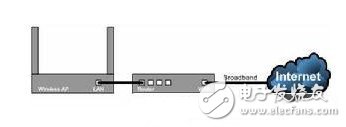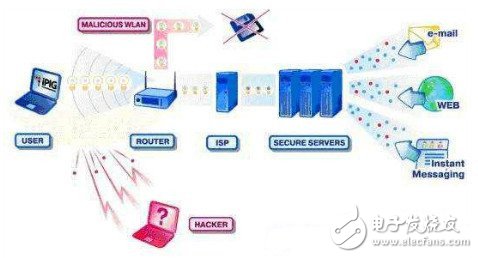When surfing the Internet, many people will find that the wireless Internet access of the computer at home is WLAN, and the Internet access of the mobile phone or tablet computer is also called WIFI. They are all the same wireless Internet, how can there be two different names, then what do wlan and wifi mean? What is the difference between wlan and wifi? Below we will introduce the specific meaning of these two Internet access methods and the difference between wlan and wifi.
What is WLANwlan (Wireless Local Area Networks) means wireless local area network, which is a data transmission system. It uses radio frequency (RF) technology for data transmission to achieve a smooth network without network cables and distance restrictions. WLAN uses the ISM (Industrial, Scientific, Medical) radio broadcast frequency band for communication. WLAN's 802.11a standard uses the 5 GHz frequency band and supports a maximum speed of 54 Mbps, while the 802.11b and 802.11g standards use the 2.4 GHz frequency band, which supports maximum speeds of 11 Mbps and 54 Mbps, respectively. The current protocol standards included in WLAN are: IEEE802.11b, IEEE802.11a, IEEE802.11g, IEEE802.11E, IEEE802.11i, and Wireless Application Protocol (WAP).

Since wireless local area networks need to support high-speed and burst data services, it is also necessary to solve problems such as multipath fading and crosstalk between subnets for indoor use. Specifically, the wireless local area network must meet the following technical requirements:
(1) Reliability: The packet loss rate of the wireless LAN system should be lower than 10-5, and the bit error rate should be lower than 10-8.
(2) Compatibility: For indoor wireless LAN, it should be compatible with the existing wired LAN in the network operating system and network software.
(3) Data rate: In order to meet the needs of LAN traffic, the data transmission rate of wireless LAN should be above 1Mbps.
(4) Communication confidentiality: As data is transmitted in the air through wireless media, wireless local area networks must take effective measures at different levels to improve communication confidentiality and data security.
(5) Mobility: Support full mobile network or semi-mobile network.
(6) Energy-saving management: When there is no data transmission and reception, the site machine is put into a sleep state, and it is activated again when there is data transmission and reception, so as to achieve the purpose of saving power consumption.
(7) Miniaturization and low price: This is the key to the popularization of wireless local area networks.
(8) Electromagnetic environment: The influence of electromagnetic on the human body and the surrounding environment should be considered in the wireless local area network.
wlan hardware device(1) Wireless network card. The role of the wireless network card is basically the same as that of the network card in the Ethernet. As the interface of the wireless local area network, it can realize the connection and communication between the clients of the wireless local area network.
(2) Wireless AP. AP is the abbreviation of Access Point. A wireless AP is the access point and wireless gateway of a wireless local area network. Its function is similar to a hub in a wired network.
(3) Wireless antenna. When the network devices in the wireless network are far apart, as the signal weakens, the transmission rate will drop significantly so that the normal communication of the wireless network cannot be realized. At this time, the received or transmitted signal must be enhanced with the help of wireless antennas.
What is WIFIWIFI (WirelessFidelity, wireless fidelity) technology is a brand of wireless network communication technology based on the IEEE 802.11 series of standards. The purpose is to improve the interoperability between wireless network products based on the IEEE 802.11 standard. -Fi Alliance). Simply put, WIFI is a wireless networking technology. In the past, computers were connected through the network, but now they are connected through radio waves. The Wi-Fi Alliance (also known as: WECA, an organization for standardization of wireless local area networks) was established in 1999. It was called the Wireless Ethernet CompaTIbility Alliance (WECA) at the time. In October 2002, it was officially renamed the Wi-Fi Alliance.

Like Bluetooth technology, wifi is a short-range wireless technology used in offices and homes. This technology uses a frequency band near 2.4GHz, which is currently an unlicensed wireless frequency band. There are two currently available standards, namely IEEE802.11a and IEEE802.11b. In the case of weak signal or interference, the bandwidth can be adjusted to 5.5Mbps, 2Mbps and 1Mbps. The automatic adjustment of the bandwidth effectively guarantees the stability and reliability of the network. This technology is favored by manufacturers because of its own advantages.
Since the implementation of IEEE 802.11b, wireless networks have made great progress. Therefore, products based on this technology have gradually increased. It is very necessary to solve the compatibility problems between products of various manufacturers. Because IEEE is not responsible for testing the compatibility of IEEE 802.11b wireless products, this work is undertaken by a non-profit organization spontaneously formed by manufacturers: Wi-Fi Alliance. This alliance includes the most important manufacturers of wireless LAN equipment, such as Intel, Broadcom, and the familiar Chinese manufacturers Asus, BenQ, etc. All products that pass the WiFi Alliance compatibility test are allowed to be marked with the "Wi-Fi CERTIFIED" mark. Therefore, when we purchase IEEE 802.11b wireless products, it is best to purchase products with Wi-Fi mark to ensure compatibility between products.
The official name of Wi-Fi (WirelessFidelity, wireless compatibility certification) is "IEEE802.11b". Like Bluetooth, it belongs to the short-range wireless technology used in offices and homes. Although this technology is inferior to Bluetooth technology in terms of data security, it is slightly better in terms of radio wave coverage. The Wi-Fi coverage range can reach about 300 feet (about 90 meters). Needless to say, the office can be used even in a smaller building.
The difference between WLAN and WIFI1. In fact, WIFI is a trademark of WLAN (Wireless Local Area Network Alliance). This trademark only guarantees that goods using this trademark can cooperate with each other, and it has nothing to do with the standard itself, but because WIFI mainly uses the 802.11b protocol, people Gradually, WIFI is used to call the 802.11b protocol. In terms of inclusion relationship, WIFI is a standard of WLAN, and WIFI is included in WLAN, which is a new technology that adopts WLAN protocol. The coverage of WiFi can reach about 300 feet (about 90 meters), and the maximum WLAN (with antenna) can reach 5KM.
2. WIFI (Wireless Fidelity), also known as the 802.11b standard, its biggest advantage is the high transmission speed, which can reach 11Mbps, and its effective distance is also very long, and it is also compatible with various existing 802.11DSSS devices. Wireless Internet has become a reality. The radio wave coverage is wide. The radio wave coverage based on Bluetooth technology is very small. The radius is only about 50 feet or 15 meters, while the radius of Wi-Fi can reach about 300 feet or 90 meters. Needless to say, the office. It can also be used in the entire building. However, with the development of wifi technology, wifi signals will cover a wider range in the future.
After the introduction, I believe everyone should know the difference between WIFI and WLAN. For most of our friends, we mainly know that WIFI and WLAN are technologies for realizing wireless Internet access, and WLAN wireless Internet access actually includes WIFI wireless Internet access, WLAN and WIFI The difference lies in the wider coverage of WLAN wireless Internet access, while WIFI wireless Internet access is more suitable for smart small digital products such as smart phones and tablet computers.
Suizhou simi intelligent technology development co., LTD , https://www.msmvape.com